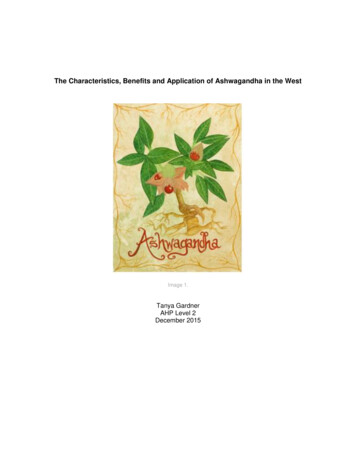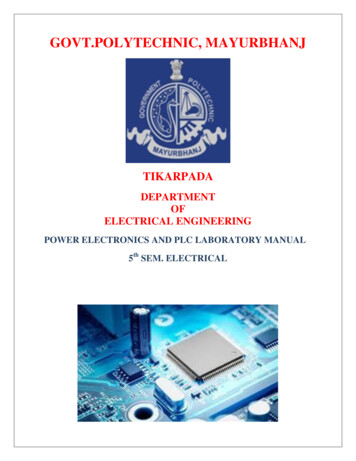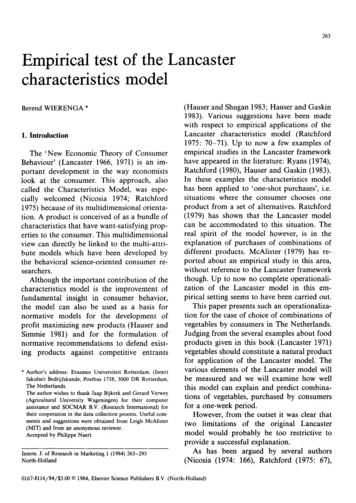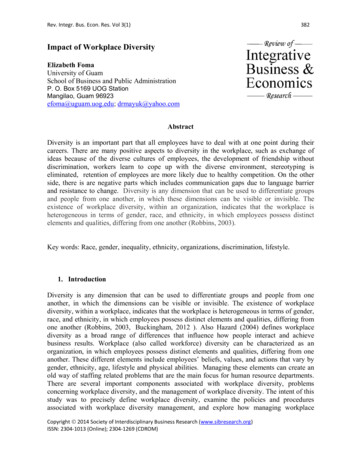
Transcription
The Characteristics, Benefits and Application of Ashwagandha in the WestImage 1.Tanya GardnerAHP Level 2December 2015
Table of ContentsINTRODUCTION 1THE PLANT . 2Image 2 .2Image 3 .2Image 4 .2DOSAGE .3SAFETY PROFILE .3BENEFITS OF ASHWAGANDHA .4Table 1: List of drug categories within which Ashwagandha is classified .4Table 2: List of imbalances treatable with Ashwagandha 5Figure 1. % change from baseline in PSS, GHQ-28, DASS, Serum cortisol .7SPECIFIC BENEFITS RELATED TO NEURODEGENERATIVE DISORDERS .7SUMMARY 8REFERENCES .9Sources of Images .12
INTRODUCTIONAshwagandha (Latin: Withania somnifera), also known as winter cherry or Indianginseng is both a tonic and a sedative due to its adaptogenic properties 1. Withania refers to theplants primary extract and somnifera literally means “sleep-inducing” 2. The nameashwagandha is derived because of two reasons – the roots of the herb smell like a horse and,there is a commonly held belief that a person consuming extracts of the herb may develop thestrength and vitality similar to that of a horse 3. Ashwagandha is also known as the “SattvicKapha Rasayana” 4. “Rasayana” is Sanskrit and literally means “path” (ayana) of the “rasa” (fluidor juice) 5. According to Sushruta, rasayanas are the substances that slow the ageing process,increase longevity and increase strength, both mental and physical 6.In the Astanga Hrdayam, Vagabhata opens the chapter on rasayanas with these words:“Long life (good), memory (great), intellegence, (perfact) health, youthfulness, (bright) complexionand colour, (bold) voice and magnanimity, increase of strength of the body and the sense organs,perfection in speech, sexual prowess and brilliance – are all obtained from rasayan therapy. It is7the best means of keeping the rasa and other dhatus in excellent condition. ”Rasayana Chikitsa (rejuvenation treatment) is a unique branch of Ayurveda. According to theCaraka Samhita, the improved quality of the rasa and other “dhatus” (tissues) supportslongevity, strength, and good “ojas” 8. Ojas is the most subtle level of the physical body and isresponsible for one’s overall strength, health and well-being 9. One of the unique features of therasayana ashwagandha is its ability to enhance the ojas. According to Caraka: “When the ojasis diminished, the person if fearful, weak, always worried, having disorders of the sense organs,deranged lustre and mental ability, rough and emaciated.” 10Used in India for thousands of years as a common home remedy, ashwagandha is oneof the most versatile medicinal plants in Ayurvedic Medicine with a wide spectrum of actions andapplications. The Caraka Samhita states ashwagandha is specific to the mamsa dhatus as itsimultaneously reduces inflammation and tonifies muscle11.It was primarily used foremaciated children and to strengthen the elderly. This was due to its rejuvenative powers andthe early healers observations that it increased the dhatus and the body weight. Stronger,higher quality dhatus also supported the srotas and allowed for any blockages to be removed12. It was observed to reduce tremors in the hands and limbs. Atriya, who lived around 1000bc1
wrote of its numerous uses and Charaka (100bc) prescribed it for hiccups and femaledisorders13.Today, ashwagandha is the most often used medicinal plant in Ayurveda14 and one ofthe most studied rasayana plants with hundreds of studies conducted for different therapeuticindications15. These therapeutic indications and ashwagandha’s associated healing propertieswill be described in this paper.THE PLANTImage 2.The LeafImage 3.The FruitImage 4.The RootAshwagandha is part of the Solanaceae, or nightshade, family (which also includestomato, potato, eggplant, peppers) and is found in India as well as Africa and theMediterranean. Its most identifiable feature is its small red berry, which looks similar to a cherrytomato. It is a woody shrub which grows to be about 2 feet in height 16. The branches form astar pattern and are covered in tomentose (hairs). The flowers are small and green the fruit isorange red 17. Ashwagandha is treated as an annual in cultivation. Its seeds are sown at thebeginning of the monsoon season and harvested 5 months later. Ashwagandha will also growwell in drought conditions18. Ashwagandha is most commonly administered as a “churna”, afine sieved powder that can be mixed with ghee, honey, milk or water19.Ashwagandha has a bitter, astringent and sweet rasa, a heating virya and a sweetvipaka. It is heavy, unctuous and vata- and kapha-reducing. It is increasing for pitta and ama.2
The dhatus benefiting from its use are rakta, mamsa, medas, asthi, majja and shukra. Primarysrotas are shukhravaha, majjavaha, and pranavaha srotas 20.Though all parts of the plant are used, it is the root that provides the mostpharmacological effect as the major extract - withanoloids (combination of steroidal akaloids andlactones) are contained therein. The primary withanoloids are withaferin A and withanolide Dwhich have been studied in the areas of oncology, immunology, neuroregeneration, andneurodegeneration. Withanolides act upon hormones as a regulator. Researchers are studyingunder the premise that if there is a particular hormone in excess, the withanolides will occupycell receptor sites so that the excess hormone cannot attach and have an effect. Depending onthe amount of the excess hormone, the withanolides behave accordingly21, 22.DOSAGEThere is no standard dose for administration of ashwaganda although 3-6 grams daily ofthe powder formula is cited most commonly23, 24 25 and seems to be provide the maximumbenefit when fresh ashwagandha powder is used 26. In addition to the powder form, milddecoctions, alcoholic extracts, mixed with ghee or honey or as a topical oil are also effectiveformulations.SAFETY PROFILESystematic studies on the safety and toxicity of ashwagandha have not been reported.Ashwagandha is generally believed to be safe though various sources cite precautions:EBSCO, the online database, recommends it should not be used by pregnant or nursingwomen, young children, or those with severe kidney or liver disease. In addition, because it hasthe potential (based on one study), to raise thyroid hormone levels27, it should not be used bypeople with hyperthyroidism. EBSCO also cautions as ashwagandha is a sedative, interactionswith sedative drugs may occur 28.Pole reports in his book that there are no known drug-herb interactions and advises tomonitor blood glucose susceptible patients due to the plants hypoglycemic activity 29. Onemonograph reports abortifacient properties of ashwagandha so use during pregnancy is to beavoided as is alcohol, sedatives and anxiolytics 30. WebMD online lists the most precautions3
adding cautions for those with stomach ulcers, preparing for surgery, thyroid disorder, and autoimmune diseases such as multiple sclerosis, lupus and rheumatoid arthritis 31.Published studies reporting no untoward effects include 18 healthy volunteers, ages 18-30receiving escalating daily doses (750mg, 1000mg, 1250mg, respectively) of Withania somniferacapsules for 30 days32. Another study with 64 human subjects with a history of chronicstressed were randomized to either placebo or treatment groups. The treatment group received300mg high-concentration full spectrum root extract for 60 days with no adverse events reported33.Finally, in Lakshmi-Chandra et al’s review paper “Scientific Basis for Therapeutic Use ofWithania somnifera”, the doses reaching acute toxicity levels in rats is approximately 450/mg/kgand in albino mice, 1750mg of aqueous solution and 1500mg of IP injection34.BENEFITS OF ASHWAGANDHAThe documented potential benefits of the use of ashwagandha is impressive. A simpleweb search of “benefits of ashwagandha” results in many published studies and sites detailingthese benefits. Note: Care should be taken when reviewing website articles that do not providereferences to the published research. In addition, within the published literature, a number ofpublished studies report inconclusive findings and make recommendations for further research.Review of the literature reveals ashwagandha falling into the following drug categories:Table 1: List of drug categories within which Ashwagandha is classified:AdaptogenAnti-oxidantDiureticNervine juvenative TonicAnti-inflammatoryAstringentNervine sedativeReproductive TonicShukrala4
Specifically, ashwagandha is documented to address the following imbalances35-47:Table 2: List of imbalances treatable with AshwagandhaAcneConstipationHiccupsPainful swellingADHDCoughHigh cholesterolParkinson’s diseaseAllergiesDementiaHuntington’s diseaseSperm count and motilityAlzheimer’s eThyroid disordersArthritis (OA and rDepressionLeukorrheaUterine fibroidsCarbunclesDiabetesLung adenomaUterine spasmsChronic FatigueDysmenorrheaLow energyVitiligoColicEpilepsyMemory LossWormsCongestionGoiterMultiple SclerosisConjunctivitisHemorrhoidsObesityIn his book, “Ayurvedic Medicine: The Principles of Traditional Practice”,Sebastian Pole summarizes many of ashwagandha’s benefits:“ stabilizing, good for insomnia, erratic digestion, constipation and anxiety. It is calming whilestrengthening, giving energy while also settling the nervous system. Can be taken morning andevening, great for enhancing stability and strength in yoga practice as well.”48Narendra Singh et al’s overview in the African Journal of Alternative ComplementaryMedicine mentions many of the known benefits in a single paragraph:“[Ashwagandha] enhances the function of the brain and nervous system and improves thememory. It improves the function of the reproductive system promoting a healthy sexual andreproductive balance. Being a powerful adaptogen, it enhances the body's resilience to stress.Ashwagandha improves the body's defense against disease by improving the cell-mediatedimmunity. It also possesses potent antioxidant properties that help protect against cellulardamage caused by free radicals.”49Adaptogens are herbs that help in combating stress. Stress is a mental or emotional strainwhich, if regularly induced over time can lead to significant imbalance or disease. Adaptogens5
also can improve the body’s performance and endurance. A recent definition in the literaturedefines adaptogens as“a class of metabolic regulators which increase the ability of an organism to adapt to and avoiddamage from environmental factors .an adaptogen should: a) decrease stress-induced damage,b) be safe and produce a beneficial effect c) be devoid of any negative effects such aswithdrawal syndromes and d) not influence the normal body functions more than necessary50.Ayurvedic classical texts, animal studies and clinical studies describe Ashwagandha asa safe and effective adaptogen posessing all of these characteristics. Modern day literatureverifies what the ancient rishis already knew about the plant’s healing properties. For example,a 2001 study conducted in rats (n 18) divided them into three treatment groups – placebo, awater suspension of 360mg/kg, and an oral compound of 20mg/kg. The rats were placed in acold environment and the time to return to normal body temperature was monitored. The ratsgiven the oral compound returned to their normal body temperature 40 minutes faster than thewater suspension group and 60 minutes faster than the placebo group51.In another study, 64 human subjects with a history of chronic stress were enrolled into astudy. At baseline the subjects’ serum cortisol was measured and a standard set of stressassessment questionnaires administered. All subjects had similar baselines questionnairescores. Subjects were randomized to either the placebo control group or the study drugtreatment group (300mg capsule of high concentration ashwagandha root) and required to takeone capsule two times per day for a period of two months. At Day 60 the serum cortisol wasagain tested and three stress assessment questionnaires administered. The perceived stressscale (PSS) questionnaire showed a 5.5% reduction in score in the placebo compared to 44% inthe ashwagandha treatment group. The results of the GHQ-28 general health questionnaireshowed the ashwagandha treatment group have improved scores ranging from 58%-89%higher compared to the placebo arm. The Depression Anxiety Stress Score (DASS) resultsshowed average reduction in depression, anxiety, and stress to be 72% decrease in theashwagandha treatment group compared to only 4.5% average decrease in placebo.Finally, the serum cortisol levels, which were at similar levels in both groups at baseline,were very different at Day 60. The ashwagandha group demonstrated at 27.9% reduction incortisol levels compared to just 7.9% in the placebo control group52. Figure 1. shows thecomparative changes from baseline to Day 60 for both the questionnaires and the cortisollevels:6
Figure 1. Percentage change from baseline in PSS, GHQ-28, DASS, Serum cortisolMore recently, adaptogens have started to be used in sports supplements to enhancephysical fitness. A very recent study conducted in 57 healthy male volunteers with limitedexperience in strength training (age range 18-50) were randomized to either a control placebogroup of 300mg daily starch capsule or to 300mg daily ashwagandha powder capsule. Subjectsattended training sessions 3 days per week to perform weight lifting repetitions of both the upperand lower body. Muscle strength, muscle size, testosterone levels, recovery time andtolerability were monitored. In each area, the ashwagandha treatment group showed significantimprovement with the exception of muscle strength in which the two groups remained equal. Noside effects were reported in either group53.SPECIFIC BENEFITS RELATED TO NEURODEGENERATIVE DISORDERSOne growing area of focus in the therapeutic effects of ashwagandha is in the treatmentneurodegenerative disorders such as dementia, multiple sclerosis, and Parkinson’s,Alzheimer’s, and Huntington’s diseases. Research in humans is extremely limited but there isa wealth of published animal studies pointing to the neuroprotective and neuroregenerativeproperties of Ashwagandha. Hypotheses surrounding ashwagandha’s potential to slow, halt orreverse the progression of neurodegenerative disorders are focused on withanolides foundwithin the plant. This group of steroidal lactones are known to have neuron and brainregenerative properties. In neurodegenerative disorders the components of the nerve cells –axons, dendrites, and the pathways upon which they travel - are destroyed. This has a negativeeffect on abilities such as perception, memory, learning and reasoning54. Animal studies todate have shown that ashwagandha regenerates damaged neurons, reconstructs the nervesignaling network55, and improves memory deficits56. The plant also re-grows dendrites57 andtherefore rebuilds brain tissue58, 59. Neuroprotective properties have shown markedimprovements in motor skills, anatomical, and behavioral impairments60,61.7
SUMMARYAshwagandha traditionally was used as a rejuvenative tonic for both children and the elderly. Itgrows in various parts of the world and is readily available, easy to store, and easy to formulate.It is one of the most utilized plants in Ayurvedic medicine and the most studied rasayana.Ashwagandha is widely accepted to be safe though would benefit from further systematicresearch into the safety profile. It is best administered as a churna mixed with ghee, milk orhoney but other formulations are also effective. Standard dosages vary with the most commonbeing 1-2 grams, three times per day. Ashwagandha is formally classified as an adaptogen.The primary pharmacological effect is derived from the roots which contain withanoloids and areattributed with giving the plant its impressive versatility. It is known as the “Indian Ginseng” andmay be widely applied to many disorders and imbalances. Most recently it has been studied inthe areas of oncology, both for tumor reduction and as a tonic post-chemotherapy, and in thearea of neurodegenerative disorders. Ashwagandha’s unique properties and the many animalstudies performed to date point positively to the fact that it acts as both a neuro-protective agentand as a neuro-regenerator. Human studies in the therapeutic area of neurodegenerativedisorders are very limited and further research is needed.8
REFERENCES1. Monograph. Withania somnifera. Altern Med Rev. 9 (2004): 211–214.2. Ven Murthy MR, Ranjekar PK, Ramassamy C, Deshpande M, “Scientific basis for theuse of Indian ayurvedic medicinal plants in the treatment of neurodegenerativedisorders: ashwagandha,” Cent Nerv Syst Agents Med Chem, 10(3) (September 2010):238-46.3. Chandrasekhar K, Kapoor J, Anishetty S, “A prospective, randomized double-blind,placebo-controlled study of safety and efficacy of a high-concentration full-spectrumextract of ashwagandha root in reducing stress and anxiety in adults,” Indian J PsycholMed 34 (2012): 255–262.4. Changhadi Govardhan Sharma, “Ashwagandharishta - Rastantra Sar EvamSidhyaprayog Sangrah,” Krishna-Gopal Ayurveda Bhawan (Dharmarth Trust) Nagpur,(1938): 743–744.5. Aapte, W, “Sanskrit Hindi Shabdkosha,” Anil Prakashan, Delhi, (2007): 815.6. Sushruta, “Sushruta Samhita, Chikitsa Sthana”, edited by Kaviraj Ambikadutta ShastriChaukhamba Sanskrit Sansthan, Varanasi, (2007): Chapter 1, Verse 15, Page 4.7. Vagbhata, Astanga Hridaya, Translated by Prof. K. R. Srikantha Murthy, Chapter 39,Verses 1-2.8. Agnivesh, Charaka, “Dridhabala, Charaka Samhita, Chikitsa Sthana, Rasayan-VajikaranAdhyaya”, 1/1 vidyotini Hindi commentary by K Shastri, G Chaturvedi; ChaukhambaBharati Academy, Varanasi. 2nd ed: (2007): 35–6.9. Badge AB, Sawant RS, Nikumbh MB, Kale AB, Dhimdhime RS, “Rasayana Chikitsa:Antiagening Therapy of Ayurveda,” Int. Res. J. Pharm., 4(4) (2013): 64-69.10. Caraka Samhita, Vol XXX, page 502.11. Charak Samhita 6000BC, Charaka translation into English: Translator: ShreeGulabkunverba Ayurvedic Society. Jamnagar, India, (1949).12. Ibid. 9.13. Atal CK, Schwarting AE, “Ashwagandha – An ancient Indian drug”, Economic Botany,Volume 15, Issue 3, (July 1961): 256-263.14. Ibid, 9.15. Balasubramani SP, Venkatasubramanian P, Kukkupuni SK, Patwardhan B, “Plant-BasedRasayana Drugs from Ayurveda” Chin J Integr Med, 17(2), (Feb 2011):88-94.16. Ibid, 1.17. Umadevi M, Rajeswari R, Sharmila Rahale C, Selvavenkadesh S, Pushpa R, SampathKumar KP, Bhowmik D, “Traditional and Medicinal Uses of Withania Somnifera”, ThePharma Journal”, Vol 1:9 (2012): 103-110.18. Heron B, “Ashwagandha: An Ancient Herb with 21st Century ories/plants/introducing-ashwagandha.Accessed on 26 December 2015.19. Singh N, Balla M, de Jager P, Gilca M, “An Overview on Ashwagandha: A Rasayana(Rejuvenator) of Ayureda”, Afr J Tradit Complement Altern Med, 8(5 Suppl). (2011): 20813.20. Pole S, Ayurvedic Medicine: The Principles of Traditional Practice, (London. SingingDragon. 2013), 133.21. Ibid.1.9
22. Kulkarni SK, Dhir A, “Withania somnifera: an Indian ginseng”, ProgNeuropsychopharmacol. Biol Psychiatry, 32 (2008):1093–1105.23. style-guide-11/supplement-guideashwagandha accessed on 27 December 2015.24. ndha-wonder-herb-of-india.htmlaccessed on 27 December 2015.25. Ibid.1.26. Singh RS, “Ashwagandha”, Vanaushadhi Nidharsika (Ayurvedic Pharmacopia) UPSansthan: (1983): 30–31.27. Panda S, Kar A, “Changes in thyroid hormone concentrations after administration ofashwagandha root extract in adult male mice”, J Pharm Pharmacol, 50, (1998): 1065-68.28. EBSCO database website: Ashwagandha p?siteid EBSCO&chunkiid 21532 accessed26 December 2015.29. Ibid.20.30. Ibid.1.31. WebMD online resource, ntmono953-ashwagandha.aspx?activeingredientid 953&activeingredientname ashwagandhaaccessed 26 December 2015.32. Raut AA, Rege NN, Tadvi FM, Solanki PV, Kene, KR, Shirolkar SG, Pandev SN, VaidyaRA, Vaidya AB, “Exploratory study to evaluate tolerability, safety, and activity ofAshwagandha (Withania somnifera) in healthy volunteers”, J Ayureda Integr Med, 3(3):(July 2012):111-4.33. Chandrasekhar K, Kapoor J, Anishetty S, “A prospective, randomized, double-blind,placebo-controlled study of safety and efficacy of a high-concentration full spectrumextract of ashwagandha root in reducing stress and anxiety in adults”, Indian J PsycholMed, 34(3), (July 2012): 255-62.34. Mishra LC, Singh B, Dagenais S, “Scientific Basis for the Therapeutic Use of Withaniasomnifera (Ashwagandha): A Review”, Alternative Medicine Review, Vol 5:4 (2000):334-46.35. Herb Wisdom.com, “Ashwagandha (Winter Cherry) ndha.html, accessed on 24 December 2015.36. Dey D, Chaskar S, Athavale N, Chitre D, “Acute and Chronic Toxicity, Cytochrome P450Enzyme Inhibition and hERT Channel Blockade Studies with a Polyherbal, AyurvedicFormulation for Inflammation”, BioMed Res Intl, Vol 2015, Article ID 971982, (2015).37. Bhattacharya SK, Bhattacharya A, Sairam K, Ghosal S, “Anxiolytic-antidepressantactivity of Withania somnifera glycowithanoldies: An Experimental Study”,Phytomedicine, 7(6), (December 2000): 463-9.38. Mirjalili M, Moyano E, Bonfill M, Cusido, R, Palazón,, J, "Steroidal Lactones fromWithania somnifera, an Ancient Plant for Novel Medicine". Molecules 14(7), (2009):2373–93.39. Misra B, “Ashwagandha”, Bhavprakash Nigantu (Indian Materia Medica), Varanasi,Chaukhambha Bharti Academy, (2004): 393–4.40. Kritikar KR, Basu BD, Withania somnifera Indian medicinal plants, 2nd Edition. IIIrd.(Allahabad. Lalit Mohan Basu.1935), 1774–6.41. Singh V, Pandey G, “Role of Withania somnifera in Prevention and Treatment of Cancer:An Overview”, Int J of Pharm Sciences and Drug Res, 3(4), (2011):274-279.10
42. ,Jayaprakasam B, Zhang Y, Seeram NP, Nair MG, “Growth inhibition of human tumorcell lines by withanolides from Withania somnifera leaves”, Life Sciences, 74 (2003):12532.43. Winters M, “Ancient medicine, modern use: Withania somnifera and its potential role inintegrative oncology”, Altern Med Rev, 11(4), (December 2006): 269-77.44. Raghavan A, Shah Z, “Withania somnifera: a pre-clinical study on neuroregenerativetherapy for stroke”, Neural Regen Res, 10(2), (February 2015): 183-5.45. Cai Z, Zhang G, Tang B, Liu Y, Fu X, Zhang X, “Promising Anti-influenza Properties ofActive Constituent of Withania somnifera Ayurvedic Herb in Targeting Neuraminidase ofH1N1 Influenza: Computational Study”, Cell Biochem Biophys, January 2015: 28.46. Ibid.17.47. Ibid.20.48. Ibid. 20, p 54.49. Ibid. 19.50. Ibid. 3.51. Panossian A, Wikman G, “Evidence-based efficacy of adaptogens in fatigue andmolecular mechanisms related to their stress-protective activity”, Curr Clin Pharmacol, 4(2009): 198-291.52. Kaur P, Sheenu M, Sharma M, Tiwari M, Srivastava K, Chandra R, “A Biolocially ActiveConstituent of Withania Somnifera (Ashwagandha) with Anti-stress Activity”, IndianJournal of Clinical Biochemistry, 16(2), (2001):195-8.53. Ibid. 33.54. Wankhede S, Langade D, Joshi K, Sinha, SR, Bhattacharyya S, “Examining the effect ofWithania somnifera supplementation on muscle strength and recovery: a randomizedcontrolled trial”, Int Soc Sports Nutr 12 (2015):43.55. Dickon TC, Vickers JC. “The morphological phenotype of b-amyloid plaques andassociated neuritic changes in Alzheimer's disease”, Neuroscience, 105 (2001): 99–107.56. Zhao J, Nakamura N, Hattori M, Kumboyama Tohda C, Komatsu K, “Withanolidederivatives from the roots of Withania somnifera and their neurite outgrowth activities”,Chem. Pharm. Bull., 50 (2002):760–5.57. Dhuley JN, “Nootropic-like effect of Ashwagandha (Withania somnifera L.) in mice”,Phytother. Res. 15, (2001):524–8.58. Tohda C, Kuboyama T, Komatsu K, “Dendrite extension by methanol extract ofAshwagandha (roots of Withania somnifera) in SK-N-SH cells”, NeuroReport, 11,(2000):1981–5.59. Dekosky S, Scheff SW, “Synapse loss in frontal cortex biopsies in Alzheimer's disease:correlation with cognitive severity”, Ann Neurol, 27 (1990):457–464.60. Prakash J, Yadav SK, Chouhan S, Singh SP, “Neuroprotective Role of Withaniasomnifera Root Extract in Maneb – Paraquat Induced Mouse Model of Parkinsonism”,Neuro Chem Res, Vol 38(5), (May 2013): 972-980.61. Rao, R, Descamps O, Varghese J, Bredesen D, “Ayurvedic medicinal plants forAlzheimer’s disease: a review”, Alzheimers Res Ther. 4(3), (2012) 22.11
SOURCES OF IMAGES accessed on 23 December 2015:Image 1: ts-ashwagandha-herb/Image lery/w500/1328192904 6706852731f2.jpgImages 3 and 4: nts/introducingashwagandha/12
fine sieved powder that can be mixed with ghee, honey, milk or water 19. Ashwagandha has a bitter, astringent and sweet rasa, a heating virya and a sweet vipaka. It is heavy, unctuous and vata- and kapha-reducing. It is increasing for pitta and am











